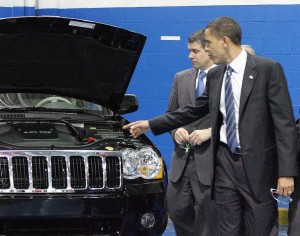
Then-candidate Barack Obama looks under the hood of a Jeep in 2008. Obama's fortunes - and his re-election - have been tied to the auto industry.
Even as analysts pour over the data trying to get a clear understanding of what led President Barack Obama to victory on Tuesday, there’s a growing sense that the auto industry played a significant role, especially in the key battleground state of Ohio.
One of the most bitterly fought presidential campaigns in decades revealed significant strengths and weaknesses for both candidates. But as so often happens, external events – such as Superstorm Sandy – and campaign missteps including “inaccurate” last-minute claims about General Motors and Chrysler may have had as much of an impact on key voters as the debates, the endless political commercials and the long lists of endorsements claimed by either side.
Perhaps nowhere is that more apparent than in Ohio, where voters’ decision in favor of the president was reported by the various TV networks as pushing Obama to re-election shortly after 11 PM EST. CNN’s chief political analyst John King, who repeatedly parsed the results from swing states down to the county level, noted that while much of Ohio was “red,” the color assigned to Republicans, “the industrial north is solidly blue” in a corridor that took in automotive manufacturing centers such as Toledo and Cleveland and its suburbs.
Those are traditionally Democratic strongholds, but would the vote have been so lopsidedly in favor of the President’s re-election, or would turnout have been quite so high if the auto industry had not been a central topic in the campaign?
Indeed, did former Mass. Gov. Mitt Romney only ensure the loss of Ohio in what many critics have described as a “desperate” last-minute “scare campaign” claiming that Chrysler’s Jeep brand was getting ready to move all its production from the U.S. to China?
That was the question that popped up repeatedly as TV talking heads watched the returns flood in from Ohio – in particular, the Northern Ohio region that reversed earlier, downstate voting favoring the Republican challenger.
NBC News was among many media outlets that examined the claims about Jeep and GM jobs that candidate Romney and his campaign made in the final week. The coverage was harshly critical – and so was the unprecedented blowback from the two automakers. None other than Chrysler CEO Sergio Marchionne declared “inaccurate” the Romney claims in a letter to employees that was also released to the media.
GM, which was also lumped into the last-minute GOP campaign strategy, went even further, spokesman Greg Martin declaring that the Republican hopeful was operating in a “parallel universe,” adding that the continued use of a clearly false claim was “campaign politics at its cynical worst.”
The controversy grew even louder — and potentially led to an even greater backlash when New York celebrity entrepreneur Donald Trump repeated the claims about Chrysler jobs in a Tweet — leading the automaker’s design chief Ralph Gilles to respond with his own Twitter post declaring Trump “full of shit.”
(Click Here for that full story.)
It may take weeks to parse through exit data and subsequent polls but in the hours after Ohio was placed in the blue column, a number of on-air analysts were suggesting the flap over Jeep clearly backfired.
But the auto industry was at the heart of the campaign almost from the moment then-candidate Barack Obama claimed victory the first time, in November 2008. That election came as the U.S. economy was sliding into the worst economic slump it has experienced since the Great Depression – and as it became apparent at least two of Detroit’s Big Three would slip into bankruptcy, perhaps transforming a deep recession into a full-fledged depression.
It was Republican President George W. Bush who began the bailout of GM and Chrysler – tapping into so-called TARP funds originally set aside to rescue the nation’s banks when Congress failed to approve an automotive bailout. But the lame-duck Commander-in-Chief left it to his successor to decide how far to go to keep the automakers afloat. And in the months after his inauguration, Barrack Obama approved additional funding that would eventually add up to $84 billion.
The new president defended his controversial and widely unpopular move, insisting it was necessary to save at least 1 million jobs and shore up a faltering economy. The man who would become his 2012 opponent, however, insisted failure was a reasonable option for the two makers in a series of speeches and op-ed pieces for publications including the New York Times.
In the more than three years since the full bailout was authorized, the topic has remained a controversial one. “It wasn’t right. The government shouldn’t be stepping into the economy like that,” lamented Dennis George, a Florida entrepreneur who lost a significant amount of money on GM stock after the maker’s 2009 bankruptcy.
Even today, polls show a sizable percentage of Americans agree with claims the bailout went too far, numbers that tend to jump whenever reports suggest the Treasury will likely lose billions of dollars once its final stake in GM is sold off.
But opposition has generally softened, those same polls show, with the rescue effort generally viewed as favorable by a small majority today. And in key automotive states, it likely worked to the advantage of the incumbent president.
“When you save the jobs and the pensions and the neighborhoods of millions of middle class Americans (like me) they remember,” said GM executive Tom Wilkinson in a Facebook quote following the news of the Obama victory.
The final Electoral College numbers may show that the path to victory would have been complete without Ohio, but winning that state certainly helped the Obama campaign and underscores the way the auto industry has been a central facet in the bitter Campaign 2012 from start to finish.
